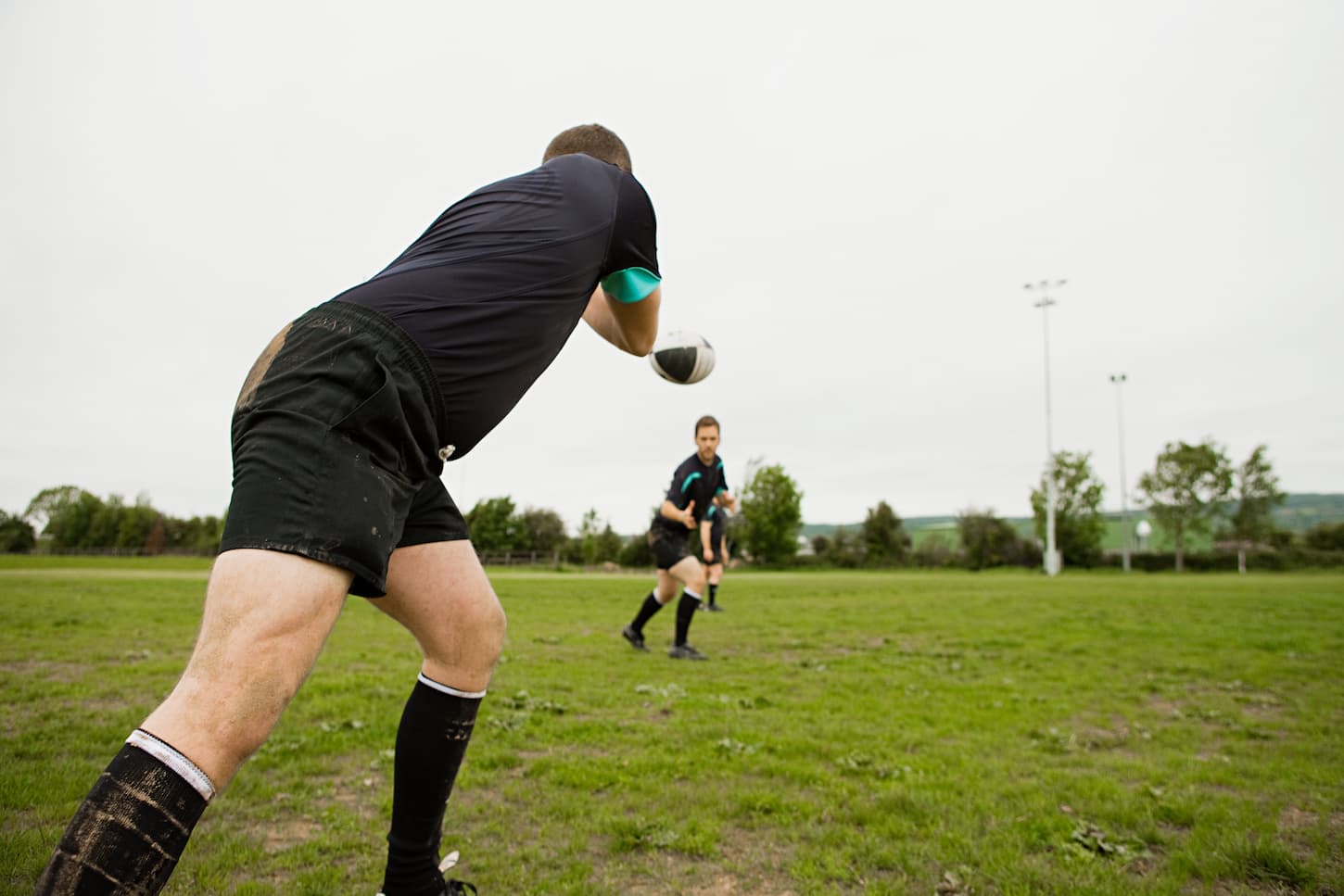How much do you know about rugby? Whether you’re a hardened fan looking to get into the sport or simply curious after watching that episode of Friends where Ross tries it out (yes, that happened). There’s always more to know about this fantastic sport.
There are several different versions or ‘codes’ of rugby, but the one that we’ll focus on here is the most popular: rugby union. This is the biggest version in terms of player base worldwide, and it’s also the version that has recently launched professionally in the US with Major League Rugby.
It’s worth saying that there are many laws of rugby union, which at first can seem confusing, but you don’t need to worry. Once you get into playing or watching, you’ll pick them up in no time at all.

Basics of Rugby Rules
First up, we’ll walk through some of the essential vocabulary of rugby. Rugby’s a pretty old game and has picked up many complicated terms, but here is an explanation of some of the most common.
Tackle
A tackle is when one player forces the other to the ground to stop them from running down the pitch.
There’s more to it than that, and we’ll cover it in more detail below in the Rugby tackling rules section.
Breakdowns
The breakdown is what happens after a tackle. There are two types of breakdowns: a ruck and a maul.
Rucks
A ruck happens after a player is tackled to the floor. Put simply, the two teams then have the chance to push against each other to win the ball or protect it.
All players must enter from the back of their side of the ruck, support their body weight with their legs, and not use their hands until the ball is at the back of their side of the ruck.
Mauls
Mauls happen when the defensive team manages to hold the player up instead of tackling the attacking player to the ground. In a maul, both teams can push and try to gain control of the ball. Just like in the ruck, players may only enter from the back of their side of the maul.
If the maul falls to the ground after the referee has shouted ‘maul!’, or the attacking team cannot pass the ball away after the referee asks them to, possession reverts to the defending team with a scrum.
Knock on
A knock-on is when a player accidentally drops the ball forwards.
Forward pass
A forward pass is when the ball is illegally passed forwards.
Offside
The offside law is a bit of a confusing one, as there are a few possibilities available scenarios. You can summarise these, though, by saying this:
The player was in front of the ball when they shouldn’t have been and then played it.
There is also a defensive offside. Defensive teams must line up behind the furthest back point of the ruck. If any player is in front of this, they’re deemed offside.
Rugby World magazine has a really handy (and more detailed) explanation of the nuances of offside and some video examples, which you can find here.
Free kick
Free-kicks are a form of sanction in rugby often awarded for minor infringements. The attacking team may choose either to run, have a scrum, or a line out awarded in line with where the free kick was.
If you’re curious about scrums and line-outs, scroll down to ‘the set piece,’ where you can find plenty.
Penalty
Penalties are a more serious form of sanction you can be awarded in rugby.
We’ll discuss these later in this article’s ‘Does rugby have penalties?’ section.

What Are The Positions in Rugby?
The positions in rugby typically fit into two main groups, the forwards and the backs. Every position in rugby is specialized and suited to particular skill levels, physiques, and temperaments.
Forwards (or the pack)
The forwards are the players who usually wear the numbers 1-8 on their shirts. Generally, forwards are the bigger, stronger players who are more likely to win and protect the ball than being seen doing fancy footwork on the edges of the pitch. They are also the players that make up the scrum and line out.
Backs
Backs typically wear numbers between 9-15 on their shirts and are generally lighter, more agile, faster, and more skillful than the forwards. However, a penchant for evasion rather than the physicality of the forwards often earns them a reputation as posers.
That’s particularly perpetuated by the older stalwarts of the rugby club, who generally see a muddy shirt as the sign of a proper game of rugby!
What Are Rugby Rules Called?
A fun fact about rugby is that technically, there are no rules; there are instead rugby laws. This is worth remembering when joining a rugby club to impress the old members with this basic but vital knowledge.
How Many Rules Are in Rugby?
Rugby union has 21 laws, codified by World Rugby, which each break down into lots of detail and clarification.
I’ve outlined the basics in this article, but if you’re looking for some real rugby nerd-level knowledge, you can find the full list here on the World Rugby website (and they even have a free app you can download).
What Is The First Rule of Rugby?
The most well-known rule of rugby is that the ball must never be thrown forwards. In rugby, you can only throw the ball sideways or backward. If the ball leaves the hands and goes forwards, it’s known as a ‘knock on’ or ‘forward pass.’ In this case, a scrum is awarded to the other team.
What’s a scrum, I hear you ask? Keep on reading to find out! We’ll cover it in a moment, I promise. But first, let’s cover some more of the rules and requirements of rugby. That way, the scrum explanation will make more sense.
Rugby Field Requirements
Rugby fields (or pitches) have several requirements. They must be 70m x 100m (76 x 109 yards) and have a soft surface such as real or artificial grass (or sometimes sand for beach rugby).
The pitch has several marked areas. These include an ‘in-goal area,’ which is the space after the try line that players can score in, of a length of between 10m and 22m (11 and 24 yards).
On the pitch itself, there is the 22-meter line (marked 22m/24 yards from each try line), the halfway line, and the 10m (11-yard) line, marked 10 meters toward each team’s try line from the halfway line.
Rugby Equipment Requirements
There’s not that much equipment required to play rugby! As a player, you’ll need cleats (or studs), shorts, socks, a shirt, and a gumshield, which you can pick up in pretty much any sports store. You’ll also need a set of posts and a ball for the game.
The posts should be 3.4 meters apart, with a 3-meter high crossbar, and must extend a minimum of 3.4 meters high.
Ball requirements
The ball comes in a variety of sizes, but for most competitive games, a size 5 ball is used. This will be 28–30 cm (11–12 in) long and 58–62 cm (23–24 in) around. A normal size 5 ball weighs 14–16 oz and has a pressure of 9.5–10.0 psi.
You can find other sizes and weights of balls for training purposes, for example, a heavy one to improve passing strength or a smaller ball for younger players.

How to Play Rugby
Rugby is a complex game, where every position uses specific skills to get the ball from your end to your opponent’s. Your objective is to score as many points as possible by touching the ball on the floor at the other end of the pitch (a try) or kicking it over the bar in various contexts that we’ll cover later in this article.
Rugby is played between two teams of fifteen players, who compete over a game of 80 minutes (split into two halves). The game doesn’t end until the ball leaves the pitch after the 80-minute mark, so you often have an exciting chance to score and win the game right at the end!
To play rugby well, you’ll have to become good at passing the ball, kicking the ball, running, tackling, and a whole load of other more specific skills! As rugby has so many different aspects, it’s a great sport for everyone, helping you build up all-around fitness.
Of course, learning how to play rugby is a lot of detail. Keep reading to learn more about the specific laws of rugby and how you can easily set up a pickup game with your friends or family in a park or backyard!
Rugby Passing Rules
The passing rules of rugby are pretty simple. The ball must only be thrown sideways or backward and must never leave the hands going forward.
If the ball goes forwards from your hands, the other team will be awarded the put-in at the scrum.
The only time that you can let the ball go forward is when you kick it. Read about this just below!
Rugby Kicking Rules
There are three ways to kick a ball in rugby:
- a punt,
- a drop-kick
- and a place kick
These are slightly different in technique, as well as achieving different goals.
A punt is when the ball is kicked directly from the hands without touching the floor or another player. This often happens in open play for lots of reasons.
- Kicking forwards and high might give your players a chance to catch the ball further down the pitch.
- Kicking to the side of the pitch might cause a line out, giving your team a territory advantage.
- Be careful when punting! There are plenty of niche rules involved in kicking, and one of the most dangerous is that, unless you’re in the last 22 meters of your side of the pitch, kicking the ball directly off the field will award the other team a line out not where it left the field, as normal, but where you kicked it. Try kicking the ball somewhere it will bounce before leaving the field to avoid this!
A drop kick is when the ball bounces on the ground before being kicked. This is how the game is started and restarted after halftime. It’s also a way to score; if you successfully drop kick the ball over the other team’s posts, your team is awarded 3 points in what’s known as a drop goal.
A place kick is another scoring attempt and is an option a team can choose when awarded a penalty or conversion (a chance to score extra points after a try). In both types of place kicks, the ball is kicked from the ground toward the posts. If it crosses over the crossbar and between the two upright posts, either 2 (for a conversion) or 3 (for a penalty) points are awarded.
If you’re curious about these two different ways to score points, don’t worry! I’ll explain them in a little more detail below in ‘How to Score in Rugby’.
Rugby Tackling Rules
You must stop other players from getting to your try line in rugby. You’ll need to physically stop them by tackling them to the ground!
In rugby, players don’t wear helmets or pads. For this reason, there are several rules in the tackle designed to protect both everyone involved;
- A player may only be tackled when in possession of the ball. No player may tackle or obstruct another if they are not holding the ball.
- A defensive player must not make contact above the attacking player’s shoulder. This is known as a high tackle.
- A defensive player must wrap their arms around the player they’re tackling. They must not ‘shoulder barge’ them.
- If a defensive player lifts another player completely off the ground in a tackle, they must put them down safely. In practice, this means that their head and back must not be the first to hit the floor, and the player’s body must not be brought past an imaginary horizontal line.
- A player may not be tackled while jumping in the air to catch the ball and must be let to return to the ground first (it’s fine for two players both to jump and try to catch the ball at the same time, but the one who manages to catch it is given priority).
- An attacking player must not jump into, or attempt to jump over, a tackle.
A player is considered tackled once their knee touches the ground. At this point, the tackler must let go of them and quickly roll to the side to be out of the way, and the tackled player must let go of the ball to let it be picked up.
Does Rugby Have Penalties?
Foul play (breaking the laws) is normally punished with a penalty in rugby. From a penalty, the attacking team has several options. They may choose to run the ball immediately, kick for goal, kick for touch, or restart play with a scrum.
If the team chooses to run the ball immediately, one player must run to the ‘mark’ where the penalty was awarded (the referee will show you where), tap it on their foot, and run. The defense must step back 10 meters before playing or risk giving away another penalty. This option is often taken when the attack feels they have an opportunity to play quickly and catch the defense tired or napping!
If the team chooses to kick at the goal, they will have an opportunity to kick the ball over the goalposts to gain 3 points. Once they choose this option, they cannot change their mind and must make a genuine attempt at scoring. This is a common option in your opponent’s half of the pitch.
If the team kick to touch and the ball goes off the field directly, they will be awarded the line-out (read about that below). For this reason, this is the most common option if the team doesn’t feel they’re in range to try to score with a place kick.
Another option is to restart play with a scrum. This option is often taken close to the try line when teams need the 7 points on offer from a try rather than the 3 from a kick. You can read more about scrums just below here!
The Set Piece
There are two types of ‘set pieces’ in rugby; scrums and line-outs.
Scrums are awarded mainly after knock-ons or forward passes. They’re a way to restart the game, with both packs of forwards pushing against each other while the ball is put in by the ‘scrum half’ (the person wearing number 9). They push and kick the ball back to be on their side.
There are many laws of scrums, which can be confusing to learn and even more tricky to notice being broken in a game! For this reason, you’ll find commentators of televised games joking about the seemingly random nature of penalties awarded after scrums.
If you are a forward (particularly front row, 1-3) or scrum half (number 9), getting more familiar with the technicalities that come up at scrum time is a good idea. You can read about those in the World Rugby law book here.
Line-outs are rugby’s equivalent to soccer’s throw-in and are a way to restart the game when the ball goes off the side of the pitch. I find them one of the most exciting bits of rugby to watch, with huge athletes being thrown into the air like gymnasts!
In a line-out, the forwards form two parallel lines, separated by a gap of one meter (just under a yard). The ‘hooker’ (no it’s not rude, it’s the player who wears the number 2 shirt) has to throw the ball straight down the middle, and players from both teams may jump to try to catch it. The teams may also lift a player to try to catch the ball, which means that the ball is often caught up to 14ft in the air!
Generally, in open play, lineouts are awarded against the team who kicked the ball out. If you kick the ball out, the other team gets to throw it in.
There are some technical exceptions to the rule – such as penalties, where the team who kicks it out retains possession, and the relatively newly introduced ’50:22’ rule (which is a little complicated but explained well by professional referee Wayne Barnes here).

How Do You Score in Rugby?
There are five ways to score in rugby. These are tries (worth 5 points), conversions (worth 2 points), penalties (worth 3 points), drop-goals (also worth 3), and penalty tries (worth 7 points).
Tries
Tries are the best way to score in rugby and are the most likely to make the highlight reels!
To score a try in rugby, you need to touch the ball down on the floor after your opponent’s try line Be careful not to go too far and run off the pitch, especially if it’s just marked with cones (as often happens at junior level!)
The ball needs to touch the ground (the try line included) with the player holding it. It’ll be considered a knock-on if they drop it before the try line. A player may touch the ball to the base of the posts and be awarded a try.
Conversions
After scoring a try, a team also has the chance to attempt a conversion to score a further 2 points. This is a form of a place kick (read about that above in ‘rugby kicking rules’). It must be taken in line with the place where the try was scored, though it’s up to the kicker to choose how far back they’d like to take it.
Choosing how far back to take the kick from gives the kick a chance to weigh up a better angle for the kick against having to kick it further to do so. To give your kicker the best chance of getting the conversion, try to score your tries directly under the posts rather than right at the edges of the pitch!
Penalty kicks
Penalty kicks are another form of a place kick (again, you can read in more detail in ‘rugby kicking rules’), which is worth 3 points. When a team is awarded a penalty, they may tell the referee that they want to attempt a place kick.
Once the team has told the referee that they will attempt a place kick, they must do so with a genuine effort. This might sound obvious, but it prevents a team from taking advantage of an opponent expecting a place pick by running, kicking the ball on the floor, or kicking across the field to another player!
As soon as the kicker begins their approach to the ball, the other team may approach them and attempt to block the ball.
Drop goals
Drop goals are probably the simplest way of scoring to explain. If a player drop kicks the ball through their opponent’s posts, they score a drop goal worth three points.
The only exception is at the kickoff, where a player may not attempt a drop goal.
Drop goals are often used as a last-minute chance to win a game. A famous example is Johnny Wilkinson’s wrong-footed drop goal to win the 2003 Rugby World Cup against Australia in extra time!
Penalty tries
Penalty tries are awarded when a team’s act of foul play is deemed to have prevented a probable or certain try. For example, a defending player might deliberately slap forwards a pass by an attacker that would have led to a scoring opportunity or might trip a player chasing a ball bouncing towards their try line.
In this case, which is often a controversial call and almost always involves the television referee (or TMO), a penalty try is awarded. This is awarded under the posts and is worth a full 7 points, with no need for the attacking team to attempt a conversion.

Other Rugby Rules Referees Must Know
Rugby referees must be familiar with all the laws of rugby, which is no small feat! However, at the top level, they also have assistant referees and a television referee, who can intervene at certain moments to help the referee.
Being a referee is a high-profile, high-pressure job in rugby. The top referees regularly attend conferences to clarify their understanding of the laws of rugby and even modify rules slightly to suit new tactical developments in the game!
That said, if you want to get into refereeing, it’s not as daunting as it might appear. Most national rugby unions will organize referee training and encourage you to take this up if it’s something you might be interested in – after all, without referees, it’s impossible for the game to exist!
Rugby Rules That Can be Relaxed For A Pickup Game
One popular way of playing pick-up rugby is to play touch rugby or ‘touch,’ a non-contact form of the game. Playing non-contact makes touch a game for all sizes, ages, and abilities – and is often played with mixed-age and gender teams!
There is a world federation of touch with codified rules and teams up to the international level! Check out the International Touch Federation’s rules here to learn how to play it.
If you want to play in the backyard, it’s easier to play with simple rules. You don’t need a full-size pitch and can easily mark a rectangular playing area with sweaters, cones, or anything else you can find.
In touch, the ball may only be passed sideways or backward, as in rugby, and to stop a player, you need to touch them with two hands simultaneously.
When this happens, the attacking player must immediately place the ball on the floor before stepping over it. The defensive team must rush back five meters (5.4 yards). A different player may then come and pick up the ball.
All the players count how many times this happens consecutively. At the sixth touch, possession is given to the other team.
There are many variations of this – a common one is to forbid any kicking, except after the fifth touch of the attacking team.
Part of the fun of backyard games like this is you can introduce your own rules, so why not play around and see what you can come up with?

Are Rugby Laws Different Than Rugby 7 Rules?
Rugby sevens is a pretty similar game to full-size rugby (otherwise known as fifteens). The key difference, other than the smaller number of players, is that the time for the game is limited to seven minutes per half.
This is because, as you’ll know if you’ve ever played it, rugby sevens is exhausting! Playing with just seven players a side on a full-size pitch means that you need to run everywhere, tackle everyone, and do a whole load more than in the full-size game!
For this reason, sevens games are played with shorter games but with tournaments that last a day or two. The games may only be fifteen minutes long, but after you’ve played four or five in one day, it becomes a pretty tiring sport!
Key Takeaways
Rugby is a thrilling sport. It’s one I got hooked on while working at a community rec center in the early morning, and the sports station ran rugby and Australian football highlight reels. Then again, I also enjoyed playing it in elementary school physical education class, where our PE teacher was a huge rugby buff ahead of rugby’s current heyday.
In any case, the most important thing to do is learn the rules and try rugby. That way, you can see if it’s your sport. Most community sports don’t offer rugby for kids yet, as it’s seen as rougher than sports like football (which counterintuitively isn’t the case).
But go grab a rugby ball and give a pickup game a go in your backyard. See what you think. If I had to choose between a pickup game of flag football or touch rugby, I’d pick touch rugby every time.
Want more rugby awesomeness? Go read our article, Soccer and Rugby: Differences and Similarities Explained next!
Resources
Learning from your own experiences is important, but learning from others is also smart. These are the sources used in this article and our research to be more informed as a family of sports nuts wannabes.
- “Federation of International Touch – What Is Touch? – Basic Rules of Touch.” FIT, www.internationaltouch.org/what-is-touch/basic-rules-of-touch. Accessed 29 Aug. 2022.
- Hathaway, Adam. “What Is Offside in Rugby Union?” Rugby World, 3 Feb. 2022, www.rugbyworld.com/takingpart/rugby-basics/what-is-offside-in-rugby-union-135761.
- “How To Know About Rucks And Mauls.” YouTube, uploaded by Sports and Outdoors, 6 Apr. 2011, www.youtube.com/watch?v=b2VQAh3MqM0.
- “New 50:22 Law Variation Explained As Only Wayne Barnes Could.” Rugby Dump, 2022, www.rugbydump.com/news/new-5022-law-variation-explained-as-only-wayne-barnes-could.
- “Rugby 101 – How the Sport Works | USA Rugby.” USA Rugby, www.usa.rugby/rugby101. Accessed 29 Aug. 2022.
- “Rugby for Beginners: A Guide to the Rules of Rugby Union.” YouTube, uploaded by RFU, 22 Oct. 2014, www.youtube.com/watch?v=FOJejnPI0p0.
- User, Super. “Rugby Rules: How To Play Rugby | Rules of Sport.” Rules of Sport, www.rulesofsport.com/sports/rugby.html. Accessed 29 Aug. 2022.
- Wayne State College, Nebraska. “Rules.” Wayne State College, www.wsc.edu/info/20165/rugby_club/707/what_is_rugby/3. Accessed 29 Aug. 2022.
- worldrugby.org. “Laws of the Game | World Rugby Laws.” World Rugby, www.world.rugby/the-game/laws/home. Accessed 29 Aug. 2022.
